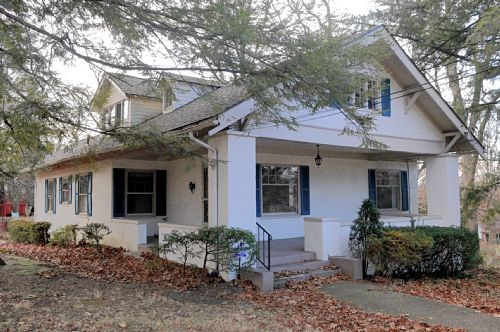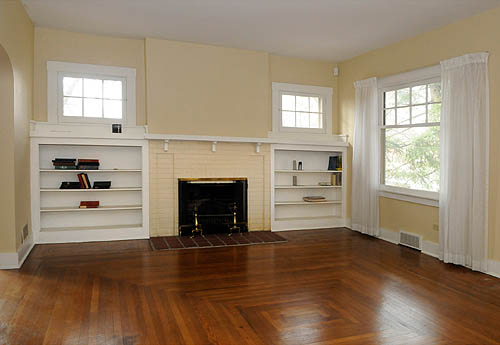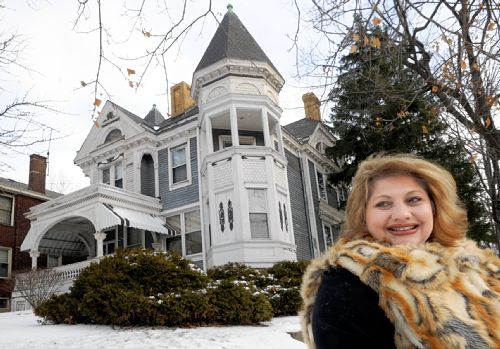
Archive: Jan 2011
-
Friendship May Get Aldi Grocery
Tuesday, January 11, 2011By Mark Belko, Pittsburgh Post-GazetteDiscount grocer Aldi appears to be headed to the East End as part of the redevelopment of a former car dealership.
Michigan-based Warner Pacific Properties is expected to brief the city planning commission today about its plans to convert the Day Automotive dealership into a grocery, offices and other retail uses.
The grocer in question is believed to be Aldi, although Leslie Peters, an attorney for Warner Pacific, said the developer did not yet have an agreement with any particular store.
Asked if Warner Pacific were talking to Aldi, Ms. Peters replied, “I think you can infer that.” City Councilman William Peduto, who represents the area, said Warner Pacific had stated that Aldi would be the grocer.
The developer is proposing an 18,000-square-foot grocery at the site at Baum Boulevard and Roup Street in Friendship. It is also planning 44,000 square feet of office space and 3,000 square feet of retail space.
Ms. Peters said Warner Pacific planned to keep the exterior intact.
The building, with a corner tower that once displayed pulsating light after dark, has some historic value. Built in the early 1930s as a Chrysler sales and service building, it remained as an auto dealership until it was closed in 2009 by the Day Automotive Group.
“We’ll be reusing the existing building,” Ms. Peters said. “We believe it’s a significant structure, at least for Pittsburghers. Everybody knows the building.”
She added that the developer did plan some interior renovations to upgrade the space. The total project cost is estimated at $4 million.
Because the property is a former auto dealership, Mr. Peduto said there are ramps within it that will allow for parking on the upper floors. The grocery will be on the first floor. He said an adjacent structure would be converted for office use.
Mr. Peduto said the project has the support of the Baum-Centre Initiative group. Through a community process, the developer is also addressing concerns about traffic patterns and other issues, he said.
After a planning commission briefing today, Warner Pacific is expected to appear before the city’s Zoning Board of Adjustment Thursday to request a special exception that would allow the property to be used for a grocery and office space.
Ms. Peters said the developer hoped to get all permits needed for the project by February or March and then start construction.
-
Buying Here: Oakmont
A fine arts-and-craft home for a young family
Sunday, January 09, 2011By Gretchen McKay, Pittsburgh Post-Gazette
This home on California Avenue in Oakmont is on the market for $249,900. Bob Donaldson / Post-Gazette
Oakmont is probably best known for its luxurious country club, home to a famously difficult golf course that’s hosted more combined USGA and PGA championships than any other course in America. But its roots actually were planted in industry; early employers along the Allegheny River included Allegheny Valley Railroad, Woodings-Verona Tool Works and Agnew & Co., one of the most prolific glass companies in Pittsburgh at the turn of the 20th century.
Along with the elegant (and uber-expensive) homes that sprang up on Hulton Road about the same time as the club, the borough is blessed with a variety of more modest turn-of-the-century homes. Pretty as a picture is a 11/2-story Craftsman bungalow at 710 California Ave. (MLS No. 842126), constructed 11 years after Oakmont incorporated as a borough in 1889. It is being offered by Howard Hanna Real Estate’s Shadyside office for $249,900 (www.howardhanna.com; 412-361-4000).
The Arts and Crafts Movement flourished in England in the mid 1800s. Yet the style — marked by architectural simplicity and natural materials — didn’t catch on in the U.S. until decades later, in the early 1900s. After the fussy opulence of the Victorian era, American homeowners welcomed uncomplicated designs that were easy to envision, build and maintain. Architect/furniture designer Gustav Stickley’s “The Craftsman” magazine, first published in 1901, proved so popular that the 200-plus house plans he designed for its pages eventually were published in two books.
Situated on a double corner lot within easy walking distance of the shops and restaurants on Allegheny River Boulevard, this house features the style’s characteristic low-pitched, gabled roof and covered front porch. Inside, the rooms are large, with minimal ornamentation, high ceilings and lots of windows. Some could some updating.
First-floor bedrooms might seem like a Baby Boomer invention, but they actually were fairly common in Craftsman bungalows. This 2,500-square-foot house has two on the main level, including a 13-by-13-foot master, plus two more upstairs. Something else that will appeal to modern sensibilities: There’s a full bath on both floors.

The 15-by-10-foot eat-in kitchen opens onto a 15-by-14-foot formal dining room. Bob Donaldson/Post-Gazette
The updated, eat-in kitchen measures 15 by 10 feet and is brightened by white wood cabinets and white appliances. It opens onto a 15-by-14-foot formal dining room, which adjoins a 20-by-14-foot living room with built-in bookcases and a working fireplace. Hardwood floors run throughout the first floor; out back is a one-car detached garage.
The large yard and quiet, tree-lined street make it a perfect starter house for a young family, says listing agent Justin Cummings. With most of the living space on the first level, it also should appeal to older couples who are downsizing but still need bedrooms for grandchildren and other visitors.

The 20-by-14-foot living room features built-in bookcases and a working fireplace. Hardwood floors run throughout the first floor. Bob Donaldson/Post-Gazette
The current owner paid $265,000 for the house in 2007. It has a 2010 full market value of $175,000
(www2.county.allegheny.pa.us).
In the past three years, eight homes have changed hands on California Avenue, ranging in price from $167,500 in May 2007 to $285,000 in July 2008 (www.realstats.net).
There will be an open house from 1 to 4 p.m. today. For more information, contact Justin Cummings of Howard Hanna’s Shadyside office at 412-361-4000 or www.howardhanna.com.
-
Owner Wants to Raze Iron City Building
Commission worries demolition will hamper future development at the historic Lawrenceville landmarkMonday, January 10, 2011By Diana Nelson Jones, Pittsburgh Post-Gazette
The pipe shop portion of the closed Iron City Brewery is falling apart at the Lawrenceville landmark, on which the city has bestowed historic status. Bill Wade/Post-Gazette
Iron City Brewing Co. president Tim Hickman sounded urgent Dec. 1 when he asked the Historic Review Commission to let him tear down one of five buildings the city had granted historic status earlier in the year.
“The roof has collapsed,” he said, describing the original ice house in the former brewing complex in Lawrenceville. “The wooden I-beams have rotted and collapsed and the west wall is collapsing.”
Last week, the commission reconvened for a hearing, and Mr. Hickman was fighting to calm his agitation as the discussion drew out. A photo projected onto a screen showed twisted metal trusses hanging in a blue background — a rectangle of sky through the roof.
The brewing company had been cited by the Bureau of Building Inspection to abate the condition, which acting bureau chief John Jennings called “very dilapidated.” But the Historic Review Commission had a longer-term concern about the building, which dates to the 1890s.
And that concern is this: Would demolition of the old ice house prove to be a terrible mistake, jeopardizing a developer’s chances of getting a 20 percent tax break should this property become part of the National Register of Historic Places?
Although Mr. Hickman said a year ago that he embraced the historic status for the economic redevelopment possibilities, he told the commission last week he has not sought national status.
This raised some commissioners’ eyebrows.
Any future development project would almost assuredly depend on the tax credit, without which the company could be stuck with a white elephant.
“Is it your intention to seek tax credits to market this property?” acting chair Ernie Hogan asked him.
“We are still trying to determine that,” said Mr. Hickman, citing the company’s uncertainty over two other buildings that are unusable unless giant tanks can be removed from them. “If I can’t get them out,” he said, “who cares that it’s historic?”
The city approved historic designation for the complex of buildings in February, which automatically kept the company from dismantling any except for one that was exempted — a non-contributing 1970s rectangle. The company still has headquarters in the original building at 3340 Liberty Ave.
Mr. Hickman originally had wanted to demolish all but the headquarters, but preservation advocates seemed to have convinced him the complex was more valuable intact.
“We’re as concerned with the history as anybody in this town,” he said last week, “but if we lose a life, I don’t care about tax credits. I have security 24/7 running off copper thieves.”
As the owner, Mr. Hickman argued, shouldn’t it be up to him whether he wants tax credits?
Mr. Hogan said the commission is responsible for making sure historic buildings have available resources for preservation.
“If that demolition were to jeopardize the integrity of the assemblage, it could jeopardize any federal money to the site,” Mr. Hogan said. “[Mr. Hickman] would be turning his back on any public subsidies.
“I think this property is important. It could be eligible for federal transportation money [being on a bus route], sustainable communities grants, HUD money, all sorts of money.”
The Penn Brewery in Troy Hill was restored using federal tax credits, he said. Similar restoration “could be a huge economic driver” for the Lawrenceville portal.
Scott Doyle, grant manager for the Pennsylvania Historical & Museum Commission in Harrisburg, said the determination of a building’s importance to an overall site “comes down to hardship or a level of significance.”
One way a building in a historic cluster could get a pass is “if it’s outside the period of significance for the property.” Other provisions exempt properties that “lack significance and do not occupy a major portion of the site, and if evidence is presented to show that retention is not economically feasible.”
The hardship provision applies “if a property is so deteriorated or altered that its integrity has been irretrievably lost,” he said.
In order to review the case, the PHMC would need a structural engineering report, photographs, historic documentation and cost estimates for repair.
The brewing company was a regional economic powerhouse in the late 19th and 20th centuries. Founded in 1861 as Frauenheim, Miller & Company, it brewed one of the country’s first golden lagers. It became the Pittsburgh Brewing Co. in 1899 in a merger of 20 regional breweries.
Among the brewery’s firsts were the snap-top can, the twist-off resealable bottle top, draft beer in cans, aluminum beer bottles and the original light beer, Mark V.
Brewing operations moved to Latrobe in summer 2009.
Last week, Mr. Hickman said he is “trying to embrace this process, but what’s the time limit? I have the city [building inspection] telling me you must do something, so I come here to do something and I’m told ‘Let’s wait.’ ”
The commission is expected to consider demolition in February, when an answer is expected about the building’s importance.
-
Saxonburg Gets $1.4 Million for Main Street
By Tom Fontaine
PITTSBURGH TRIBUNE-REVIEW
Friday, January 7, 2011Saxonburg has received a $1.4 million state grant to make long-awaited improvements along historic Main Street without robbing any of its 19th century charm.
“We’re going to take new materials and create an atmosphere like it was in the 1850s and ’60s,” said Ray Rush, who will oversee the project for the tiny Butler County borough.
Saxonburg’s grant was the largest of six totaling more than $4.4 million announced Thursday by PennDOT. The agency awarded almost $25 million statewide through its Pennsylvania Community Transportation Initiative. The program provided $59.2 million for transportation projects in 2009.
Saxonburg will use its money to install new curbs, brick sidewalks, planter strips with trees, and period lighting along 1,100 feet of Main Street. That will cover roughly half of the area that is recognized as a historic district both nationally and by the state.
The borough can trace its roots to engineer John Roebling, famed for his designs of wire cable and suspension bridges. He designed and developed Saxonburg almost four decades before he began designing the Brooklyn Bridge in the late 1860s.
“It’s important to celebrate the old. It’s something all communities should be concerned about,” Rush said. The work will begin next fall and should be completed in 2012.
The city of Pittsburgh will receive $280,000 for a traffic study in the Strip District and Lawrenceville related to its Allegheny Riverfront Green Boulevard development project. The city wants to help make its largely industrial Allegheny riverfront home to lush green spaces, trails, housing, commercial development and commuter rail.
“This most recent grant will allow us to continue the positive momentum that is happening in these vibrant neighborhoods,” said Mayor Luke Ravenstahl.
Other grant recipients include:
• Richland, $1.3 million, to improve pedestrian access and traffic flow near the intersection of Route 8 and Ewalt Road.
• Airport Corridor Transportation Association, $700,000, to reduce congestion and provide better transit, pedestrian and bicycle access in the Robinson and North Fayette commercial area.
• Washington County, $443,500, to develop 9 miles of recreational trail to complete the Panhandle Trail between Carnegie and Weirton, W.Va.
• Armstrong County, $300,000, to perform a traffic study in Kittanning.
-
Historic Panel Gives a Reprieve to Igloo
Thursday, January 06, 2011By Mark Belko, Pittsburgh Post-GazetteThe Civic Arena has won a bit of a lifeline.
A bid to protect the 49-year-old landmark from demolition got a boost Wednesday when the city’s historic review commission gave preliminary approval to its nomination as a city historic structure.
The 5-1 vote clears the way for a formal hearing Feb. 2 on the proposed designation, one opposed by the Pittsburgh Penguins and the arena’s owner, the city-Allegheny County Sports & Exhibition Authority. John Jennings, acting chief of the city’s Bureau of Building Inspection, cast the no vote.
Even as it gave preliminary approval, the commission stated that the decision was not a determination on the merits of the application for historic status filed by Hill District resident Eloise McDonald.
In fact, nine years ago, the commission gave preliminary approval to the arena’s designation as a historic structure only to reject it in a final vote.
Nonetheless, Ms. McDonald said afterward that she was thinking “very positive” on the chances of getting a final vote in favor of the nomination. But she added it could be a tough sell since Mayor Luke Ravenstahl, who appoints historic review commission members, favors demolition.
“I’m going to stay optimistic to the final decision,” she said. “But like I said, I know the politics of the game.”
However, Ernie Hogan, the commission’s acting chair, said afterward that the mayor is “not telling us what decision to make” on the nomination.
“We have a charter to uphold regarding preservation standards. That’s all he’s saying, do your job,” Mr. Hogan said.
In arguing the case for the nomination, Ms. McDonald said the arena, with its retractable roof, is unique.
To tear it down would be “just awful,” she said. “There’s a lot of young kids, if they would ever see that dome open, there would be a whole lot more support for it. If you’ve never seen it open, you have no idea how extravagant and beautiful it is.”
The preliminary finding is a setback for the SEA and the Penguins, who have the development rights to the land that includes the arena. The team wants to demolish the structure to make way for a residential, office and commercial development.
Travis Williams, the Penguins’ senior vice president of business affairs and general counsel, declined comment on Wednesday’s decision.
But Shawn Gallagher, an attorney for the SEA, said the agency does not believe the Igloo meets the criteria for historic status. Describing Ms. McDonald’s nomination as “frivolous,” he said the same criteria used to nominate the arena eight years ago — and rejected — is being used this time.
And while Ms. McDonald spoke of the marvel of the retractable roof, Mr. Gallagher said it “never really worked” and doesn’t work anymore.
“It’s not worthy of preservation,” he said of the arena, adding it is costing the SEA and taxpayers about $65,000 a month to maintain it.
The Penguins moved from the arena to the Consol Energy Center across the street last summer.
Scott Leib, president of Preservation Pittsburgh, noted that state preservation officials have determined that the building is eligible for the National Register of Historic Places.
“We’re not trying to obstruct progress. We just have a totally different view of what progress is,” he said.
Wednesday’s vote prevents the SEA from demolishing the structure until a final determination is made on its status. However, the agency did not plan to start the razing until spring at the earliest.
Once the historic review commission has completed its work, the nomination must be considered by the city planning commission and city council before the arena’s final fate is known.
-
Steelpan City
Pittsburgh City Paper
For the Week of 01.05.2011 / 01.12.2011
BY ANDREW MOORE

Jonnet Solomon-Nowlin - Steelpan Drum Instructor, owner of The National Opera House in Lincoln-Lemington - Brian Kaldorf
A local woman is hoping that the sounds of steelpan drums can revitalize one of the city’s most historic homes and the lives of young people.
The National Opera House, located on the border of Homewood and Lincoln-Lemington — and once the home of the National Negro Opera Company — has sat vacant for years. But now Jonnet Solomon-Nowlin, the building’s owner, believes her family’s U.S. Steelpan Academy can add value and structure to young lives, while bringing attention to the neighborhood’s often-overlooked past.
Steelpan drums were invented in the Caribbean — in countries like Guyana, and Trinidad and Tobago — during the 1930s. Steelpans were originally crafted from discarded 55-gallon oil drums. To achieve their signature pitched sound, two rubber-tipped mallets strike the surface of the pan, where notes have been marked onto the stretched steel surface.
Starting at the age of 14, Solomon-Nowlin’s father, Phil Solomon, founded several steelbands in Guyana; he was named Musician of the Year in 1971. After moving to Pittsburgh in 1984, he founded Solomon Steelpan Company and began manufacturing steel drums for organizations throughout the country. Solomon was the first manufacturer of steelpans in Pittsburgh.
After dedicating years to this instrument, Solomon wants the next generation to take over.
“The whole idea of the academy,” he says, “is to launch the steelpan into the 21st century, for me to pass this knowledge on to younger people.”
Solomon-Nowlin hopes not only to pass on that knowledge, but to teach young people a skill that can add value to their community.
“I would like to see steelpan and the arts and music help young people,” Solomon-Nowlin says, “by giving them an opportunity to express themselves through art.”
While she’s working to restore the Opera House, for the past several years Solomon-Nowlin has been able to teach lessons through community partnerships. And when she begins a new series of classes at the East End’s Union Project this month, it will be a step closer to running the academy within the National Opera House.
The Union Project lessons are important, she says, “and the first set of students will be a marketing piece for the house.”
Using the house as the home base for the Steelpan Academy makes sense. After all, the building has always had a role in the emerging African-American art scene, especially during the previous century.
The three-story Victorian home sits on a terrace overlooking Homewood. Built in the Queen Anne style in 1894, it was home to many prominent black Pittsburghers over the years, including Roberto Clemente, Lena Horne and Woogie Harris, brother of famed photographer Charles “Teenie” Harris.
But its most significant tenant was Mary Cardwell Dawson’s National Negro Opera Company. Launched in 1941, the NNOC was the first African-American opera company in the country. The NNOC held productions for 21 years and traveled to Washington, D.C., New York City and Chicago.
Solomon-Nowlin says she learned about this history through the advocacy efforts of the Young Preservationists Association of Pittsburgh (YPA) and the group’s executive director, Dan Holland.
The YPA is a preservation group that encourages young people to be involved in researching, documenting and eventually restoring historic places. Once a year, the organization releases a Top Ten list of the best opportunities for preservation in the region. In 2003, the Opera House was on that list.
“Their Top Ten list and the education around it, and why it’s important to preserve,” Solomon-Nowlin says, “is one of the key things that brought awareness to the project. They were able to reach a lot of people.”
And that’s what Solomon-Nowlin is hoping to do with Steelpan.
The Young Men and Women’s African Heritage Association, headquartered on Pittsburgh’s North Side, has been teaching steelpan for 15 years, and the Solomon family has been involved since the beginning. Lessons were first taught by Phil Solomon and later his daughters, Janera and then Jonnet. Jonnet gives lessons on Saturdays at the New Hazlett Theatre.
Janice Parks, executive director of the heritage association, says the steelpan is a good fit for her students.
“It’s an easily accessible instrument,” Parks says. “You don’t have to have years and years of experience to be great. [Students] can pick up two mallets and an hour later they can play the melody line of a tune that’s familiar to them.”
Adam Warble, an instructor at the academy, agrees, and says “it’s definitely a popular instrument — it’s fun.” Warble says that his young students get particularly excited when he mentions current hip-hop songs that feature steelpan. But Phil Solomon stresses the versatility of the instrument. “Steelpan was actually created to play classical music,” he says.
Parks says her students learn to play everything from “Bach and Beethoven to Stevie Wonder.”
When the academy begins teaching at the Opera House, Warble thinks it will be “absolutely wonderful. Especially since the steelpan was invented in the Caribbean” — where the culture is heavily influenced by the African diaspora. “[And] since [the home] was a hub of African-American cultures, I think it’s wonderful to bring that back to the Opera House.”
The next step is bringing back the house itself. Solomon-Nowlin has recently hired grant-writers to find funding for the home’s restoration. Architects, electricians and carpenters have all agreed to work with her, and some have already donated time to the project.
Now, she just needs to raise enough money to begin the restoration, and to begin turning the Opera House back into a home for music. But she’s quick to point out that because her forte is music, she can use all the help she can get on the restoration side of this dream.
“I’m not in the preservation business,” she says with a laugh, “I’m just in it by default. My key thing is to just make sure it’s preserved. We really have to push forward.”
-
Some in Carrick Strive to Save Victorian House
Friday, December 24, 2010By Diana Nelson Jones, Pittsburgh Post-Gazette
Julia Tomasic of the Carrick-Overbrook Historical Society is trying to save the last great Victorian home in Carrick, at 1425 Brownsville Road, by nominating it for historic status. Bob Donaldson/Post-Gazette
At one corner of Brownsville Road and The Boulevard in Carrick sits state Rep. Harry Readshaw’s funeral home. Across The Boulevard, a late-19th-century Queen Anne house is the last of the grand Victorians remaining on the main drag.
Its owners want to sell and may have a buyer in Mr. Readshaw, who said he is interested in buying the property and that demolishing it to provide parking “might be a decision to be considered.”
Mr. Readshaw’s interest has spurred the Carrick-Overbrook Historical Society to try to save the house.
Historical society member John Rudiak documented the property and this week nominated it for historical designation. He said demolition of the house would put an end to any evidence of Carrick’s Victorian heritage.
The nomination would stall any plan to demolish the house until the Historic Review Commission could determine whether it is eligible, based on a set of federal criteria. Eligibility ultimately must be decided by Pittsburgh City Council. Historic status regulates changes to a building’s exterior but not to its interior.
Richard C. Gasior, whose wife’s family has owned the four-bedroom home since 1952, said the family needs to sell it and has been advised that $150,000 would be a fair price. “If I can’t get anybody to buy it, I’m going to go with Readshaw,” he said.
Known as the Wigman House, it was built in the late 1800s by William Wigman, owner of Wigman Lumber on the South Side. The nomination states that it is “the last remaining example of several homes of the wealthy South Side gentry who lived in Carrick.”
The current owners gave a tour to members of the Carrick-Overbrook Historical Society several weeks ago, said Julia Tomasic, a founding member of the society.
“We’d love to buy it, but there are just three of us” in the society, which has no money, Ms. Tomasic said. “It has a brand-new furnace, a slate roof and the interior woodwork and walls in original hardwood, with six fireplaces, including one converted for wood. Nothing has been done to alter it.”
According to the Pittsburgh code for historic preservation, a property must meet at least one of 10 criteria to be eligible for preservation.
The nomination papers cite several possible eligibilities. One is that the home, a classic American Queen Anne, has not been modified. Its features include an asymmetrical facade, front-facing gable, overhanging eaves, polygonal tower, shaped and Dutch gables, a porch covering part or all of the front facade, a second-story porch or balconies, pedimented porches, dentils, spindles, differing wall textures including fish scales, and oriel and bay windows.
“We heard rumors for a year that Harry [Readshaw] would buy it to tear it down, and we thought it was a joke because we consider Harry a friend of the neighborhood,” Ms. Tomasic said. “Parking? You park on the street. We’re city people.”
“It’s not like I’m sitting here champing at the bit with a sledge hammer,” Mr. Readshaw, D-Carrick, said, “but business is business and any business is looking to improve its services.”
“And if we don’t get it, what happens to it?” he said. “Somebody dying to live in a big Victorian who would be a wonderful neighbor would be a positive.” A Section 8 landlord is a more likely prospect, he said, adding, “The 29th Ward has been inundated with Section 8 housing.”
Brownsville Road once had several grand Victorian homes owned by prominent businessmen. As a hilltop neighborhood, Carrick was a refuge from the smoky city. Through much of the 20th century, it was solidly middle class and owner-occupied. It remains so, but some of its stability is eroding.
In its argument for historic status, the historical society calls the Wigman House the most prominent home in Carrick, “our crown jewel Victorian.” Losing it would be a shock, the document reads, and “one more loss that we cannot sustain.”
-
This Beautiful Structure Must Be Saved
Pittsburgh Post-Gazette
Wednesday, January 05, 2011 05:00 AM
*Open Letters is a place where the letters to the editor published by the Post-Gazette are offered up for broader comment and discussion.
The late 19th-century Queen Anne Victorian house on Brownsville Road in Carrick (“Some in Carrick Strive to Save Victorian House,” Dec. 24) is a gem that must be preserved.
The Carrick-Overbrook Historical Society has done a yeoman’s job by documenting the property known as the Wigman House and nominating it for historical designation. One hopes that other area historical societies and individual philanthropists will join together to assure its salvation.
While I was growing up on Madeline Street in Carrick, dozens of comparable homes in the area reflected the personalities of the moguls who built them on high ground in order to contemplate the night sky burned red by the glow of steel mills blazing far below.
My family’s physician, Dr. Askins, was able to purchase one such mansion on Brownsville Road during the Depression. The exterior, painted contrasting shades of green, emphasized the eerie atmosphere that would have captivated the Addams Family.
Each time we visited his office, I was startled by creaking sounds — veritable moans — coming from one of the turrets. When I asked him about them, he tossed me a sly smile. “Those are the ghosts of the original owners,” he said. “They cannot bear to leave the tower and lose sight of the city they built.”
Just as those ghosts clung to the past, so must the ghosts of the last remaining Victorian mansion in Carrick be appeased.
EMILY PRITCHARD CARY
Scottsdale, Ariz.
